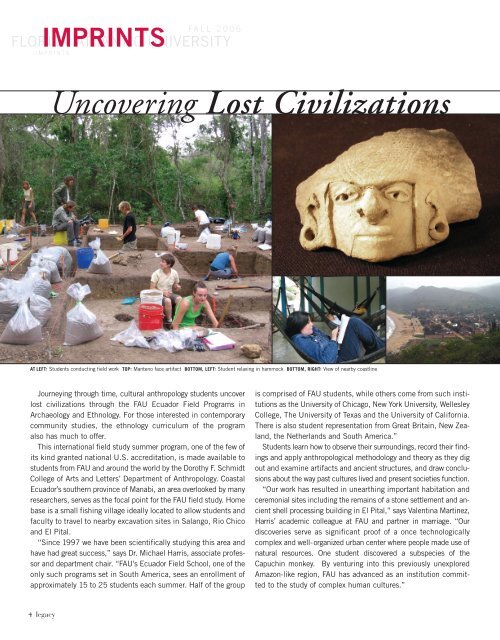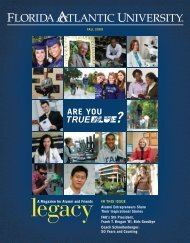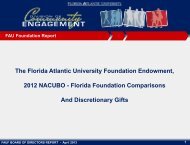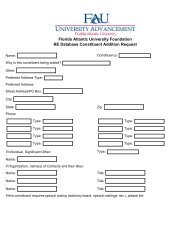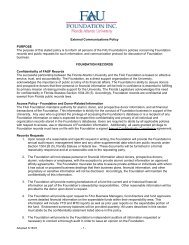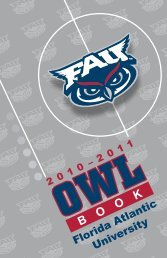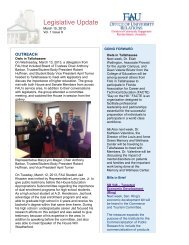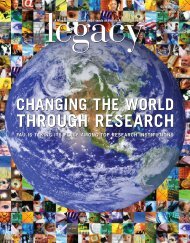Download this publication as PDF - FAU Foundation, Inc. - Florida ...
Download this publication as PDF - FAU Foundation, Inc. - Florida ...
Download this publication as PDF - FAU Foundation, Inc. - Florida ...
You also want an ePaper? Increase the reach of your titles
YUMPU automatically turns print PDFs into web optimized ePapers that Google loves.
FA L L 2 0 0 6<br />
FLORIDA IMPRINTS<br />
ATLANTIC UNIVERSITY<br />
I M P R I N T S<br />
Uncovering Lost Civilizations<br />
AT LEFT: Students conducting field work TOP: Manteno face artifact BOTTOM, LEFT: Student relaxing in hammock BOTTOM, RIGHT: View of nearby co<strong>as</strong>tline<br />
Journeying through time, cultural anthropology students uncover<br />
lost civilizations through the <strong>FAU</strong> Ecuador Field Programs in<br />
Archaeology and Ethnology. For those interested in contemporary<br />
community studies, the ethnology curriculum of the program<br />
also h<strong>as</strong> much to offer.<br />
This international field study summer program, one of the few of<br />
its kind granted national U.S. accreditation, is made available to<br />
students from <strong>FAU</strong> and around the world by the Dorothy F. Schmidt<br />
College of Arts and Letters’ Department of Anthropology. Co<strong>as</strong>tal<br />
Ecuador’s southern province of Manabi, an area overlooked by many<br />
researchers, serves <strong>as</strong> the focal point for the <strong>FAU</strong> field study. Home<br />
b<strong>as</strong>e is a small fishing village ideally located to allow students and<br />
faculty to travel to nearby excavation sites in Salango, Rio Chico<br />
and El Pital.<br />
“Since 1997 we have been scientifically studying <strong>this</strong> area and<br />
have had great success,” says Dr. Michael Harris, <strong>as</strong>sociate professor<br />
and department chair. “<strong>FAU</strong>’s Ecuador Field School, one of the<br />
only such programs set in South America, sees an enrollment of<br />
approximately 15 to 25 students each summer. Half of the group<br />
is comprised of <strong>FAU</strong> students, while others come from such institutions<br />
<strong>as</strong> the University of Chicago, New York University, Wellesley<br />
College, The University of Tex<strong>as</strong> and the University of California.<br />
There is also student representation from Great Britain, New Zealand,<br />
the Netherlands and South America.”<br />
Students learn how to observe their surroundings, record their findings<br />
and apply anthropological methodology and theory <strong>as</strong> they dig<br />
out and examine artifacts and ancient structures, and draw conclusions<br />
about the way p<strong>as</strong>t cultures lived and present societies function.<br />
“Our work h<strong>as</strong> resulted in unearthing important habitation and<br />
ceremonial sites including the remains of a stone settlement and ancient<br />
shell processing building in El Pital,” says Valentina Martinez,<br />
Harris’ academic colleague at <strong>FAU</strong> and partner in marriage. “Our<br />
discoveries serve <strong>as</strong> significant proof of a once technologically<br />
complex and well-organized urban center where people made use of<br />
natural resources. One student discovered a subspecies of the<br />
Capuchin monkey. By venturing into <strong>this</strong> previously unexplored<br />
Amazon-like region, <strong>FAU</strong> h<strong>as</strong> advanced <strong>as</strong> an institution committed<br />
to the study of complex human cultures.”<br />
4 legacy


